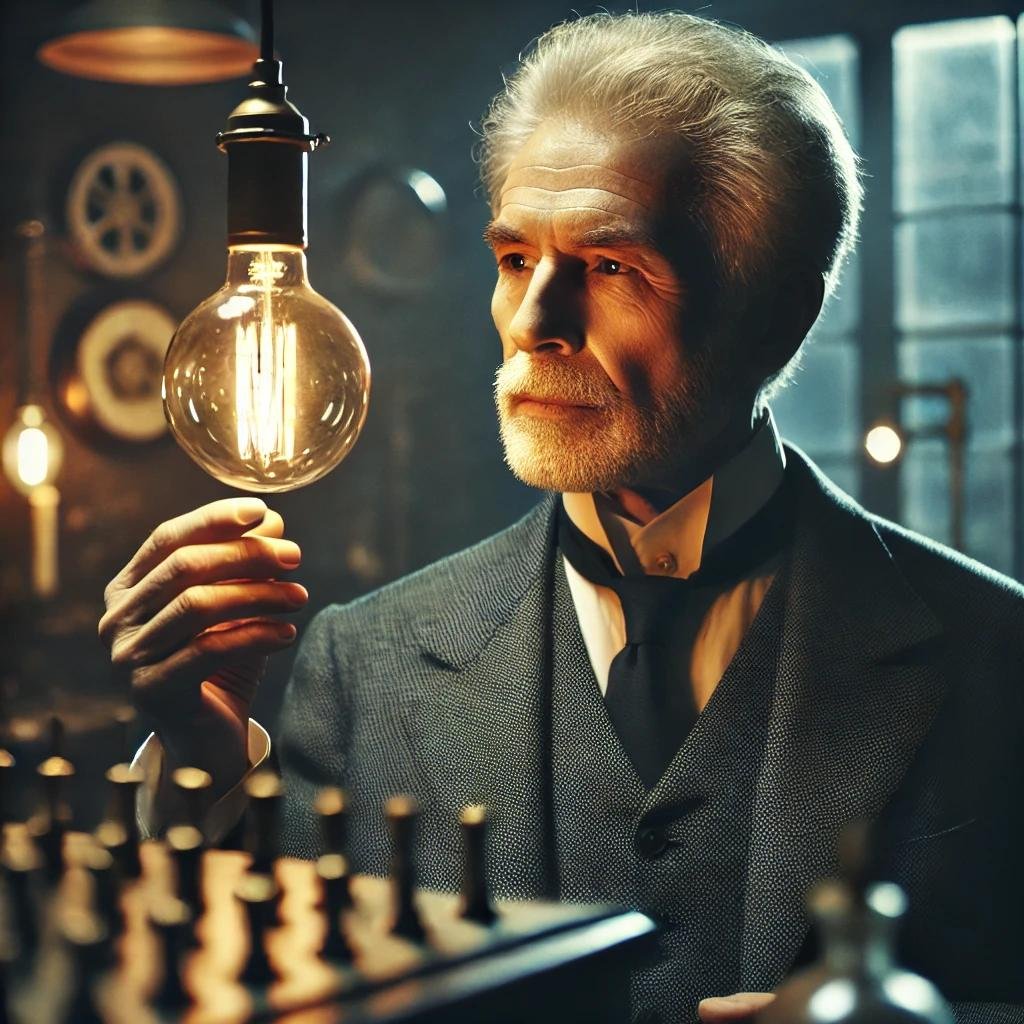Explore the inspiring journey of Thomas Edison, in this article, we’ll explore Edison’s early life, his youthful struggles, his famous failures, and how he ultimately succeeded. Edison’s life story is more than a tale of invention—it’s a profound lesson in how perseverance in the face of repeated setbacks can lead to world-changing success.
Thomas Edison’s Early Life and Childhood
Humble Beginnings in Ohio
Thomas Alva Edison was born on February 11, 1847, in Milan, Ohio, USA. His early life was far from privileged. He was the youngest of seven children born to Samuel Edison, a Canadian political exile, and Nancy Matthews Elliott, a schoolteacher. The family struggled financially, but it was his mother’s homeschooling that shaped his early education. Edison only had a few months of formal schooling, as he was considered “difficult” due to his curious, questioning nature.
Early Signs of Curiosity
From an early age, Edison demonstrated an insatiable curiosity. By the age of 12, he had already set up his chemistry lab in his parents’ basement. His first job came at 12, where he sold newspapers on trains running between Port Huron and Detroit. This was no ordinary job for Edison—it was during this time that he began experimenting with printing presses and telegraph machines, sparking his lifelong interest in innovation.
Challenges in Schooling and Hearing Loss
Edison’s school life was short-lived because his teachers labeled him as “addled.” His constant questions frustrated them, and as a result, his mother decided to homeschool him. Edison also began to lose his hearing during his early teenage years, which many attribute to either scarlet fever or a traumatic incident involving a conductor on a train. It was during this time that a life-altering event occurred. While Edison was conducting experiments, a fire broke out in the baggage car. This incident caught the attention of the train’s conductor, who, in a fit of rage, reportedly grabbed Edison by the ears and yanked him off the train. The violent action is said to have severely damaged Edison’s hearing, contributing to the deafness that affected him for the rest of his life. This hearing loss, however, never dampened his spirit; in fact, Edison claimed it helped him focus more on his work.
The Role of Hearing Loss in Edison’s Work
The hearing loss caused by the violent train incident and scarlet fever became a pivotal point in Edison’s life. Although initially seen as a setback, Edison himself believed that his partial deafness was a blessing in disguise. It allowed him to concentrate more deeply on his experiments, with fewer distractions from the world around him.
Edison didn’t let his hearing impairment hinder his work. In fact, his sensory loss seemed to heighten his focus and drive. He once said, “I never did anything worth doing by accident, nor did any of my inventions come by accident; they came by work.” His commitment to solving problems through sheer hard work and determination would become a defining characteristic of his life.
Edison’s Youthful Ambition and Early Career Struggles
First Inventions and Early Failures
After leaving school, Edison worked a variety of jobs, including as a telegraph operator. During this time, he continued to experiment with different devices, but his first inventions were not the immediate successes he hoped for. One of his first creations, an electric vote recorder, failed to gain any commercial traction, leading to a harsh realization: even brilliant inventions could fail if there wasn’t a market for them.
Struggles in Business
Financial difficulties marked Edison’s early career. He lost nearly all of his savings while working on an ill-fated telegraph machine that promised to improve stock market reporting. Despite the setback, Edison refused to give up. His resilience during this period would later become a hallmark of his approach to innovation.
Marriage and Family Life
In 1871, Edison married Mary Stilwell, a 16-year-old worker in one of his labs. They had three children together, but tragically, Mary died at the young age of 29. His obsessive commitment to his work often overshadowed Edison’s family life, and he later remarried Mina Miller in 1886. Though he had personal losses and family struggles, Edison’s passion for his work remained unshaken.
The Power of Perseverance: Edison’s Major Failures and How They Led to Success
The Light Bulb: 1,000 Failures Before Success
Edison’s persistence is perhaps best exemplified in his work on the electric light bulb. Before perfecting the incandescent bulb, Edison tried and failed over 1,000 times. Each experiment brought him closer to the breakthrough that would illuminate the world. When asked about his failures, Edison proudly responded, “I have not failed. I’ve just found 10,000 ways that won’t work. “Finally, in 1879, Edison successfully developed a practical and long-lasting light bulb. This invention alone transformed industries, homes, and cities, but it was the culmination of years of relentless experimentation, many of which were deemed failures at the time.
Phonograph: A Game-Changing Success
In 1877, Edison invented the phonograph, which was the first device to record and reproduce sound. This invention gained widespread attention and catapulted him to fame. Unlike the light bulb, the phonograph was an almost immediate success. It revolutionized how people consumed music and laid the foundation for future sound-recording technology.
Commercial Failures: Cement and Mining Ventures
Not all of Edison’s inventions were successful. Many of his business ventures outside of his core expertise failed. His attempt to enter the cement business and his venture into mining were both financial disasters. Edison lost significant sums of money and faced ridicule from his peers. However, even in these failures, Edison learned invaluable lessons about business and product development, which he applied to future inventions.
Thomas Edison’s Legacy: A Lasting Impact on the World
The Wizard of Menlo Park
Edison set up his famous laboratory in Menlo Park, New Jersey, in 1876, which became the birthplace of many of his groundbreaking inventions. His team, sometimes referred to as “muckers,” worked tirelessly under his direction, contributing to the invention of the phonograph, the motion picture camera, and improvements in telegraphy. Menlo Park became a symbol of innovation and creativity, and Edison was soon dubbed the “Wizard of Menlo Park.”
Motion Picture Camera: The Birth of Cinema
Edison’s invention of the Kinetograph, one of the first motion picture cameras, changed the entertainment industry forever. While Edison didn’t invent cinema by himself, his work on early film cameras and projectors played a crucial role in the development of modern movies. This achievement again demonstrates how Edison’s work laid the groundwork for technological advancements that we still benefit from today.
Edison’s Motivational Lessons: Turning Failure Into Success
Embracing Failure as a Stepping Stone
One of the most powerful lessons we can learn from Thomas Edison’s life is that failure is often the precursor to success. His resilience in the face of repeated failures shows that innovation often requires enduring frustration and disappointment. For Edison, each failure was just a step closer to success, as evidenced by his famous quote, “Our greatest weakness lies in giving up. Success is when you keep pushing yourself to try one more time.
Dedication and Focus
Edison’s relentless work ethic is another inspiring aspect of his character. He often worked 16-hour days and was known to sleep in his lab. His dedication serves as a powerful reminder that significant achievements require immense focus and effort.
Collaboration and Teamwork
Although Edison often received solo credit for his inventions, his work was a team effort. He relied heavily on his colleagues and staff to help execute his ideas, illustrating the importance of teamwork in achieving great things
FAQs
How many times did Thomas Edison fail before succeeding with the light bulb?
Edison famously experimented over 1,000 times before successfully inventing the incandescent light bulb. His perseverance became a hallmark of his career.
Did Thomas Edison go deaf?
Yes, Edison suffered from hearing loss, which began in his early teens. He claimed this allowed him to concentrate better on his work.
What were Thomas Edison’s most famous inventions?
Edison is best known for inventing the phonograph, the incandescent light bulb, and contributions to early motion picture technology.
Was Thomas Edison ever financially unsuccessful?
Yes, many of Edison’s business ventures failed, particularly his attempts at commercial mining and cement production. However, he never let these failures deter him from further innovation.
How did Thomas Edison’s inventions change the world?
Edison’s inventions such as the light bulb, phonograph, and motion picture camera revolutionized industries and improved daily life for millions of people worldwide.
Did Edison work alone on his inventions?
No, Edison worked with a team of talented engineers and scientists in his laboratory, particularly at Menlo Park, where many of his significant inventions were developed.
Conclusion
Thomas Edison’s life is a testament to the power of perseverance, vision, and tireless work. He wasn’t an overnight success; his journey was riddled with failures, but each setback propelled him closer to greatness. Whether it’s the thousands of failed light bulb experiments or his numerous unsuccessful ventures, Edison’s story reminds us that true success often comes from learning from failure and never giving up.
By reflecting on Edison’s life, we find an inspiring example of how passion and resilience can change the world. His legacy, from the light bulb to the phonograph, serves as a reminder that innovation knows no bounds for those who dare to persist.


1 Comment
So nice